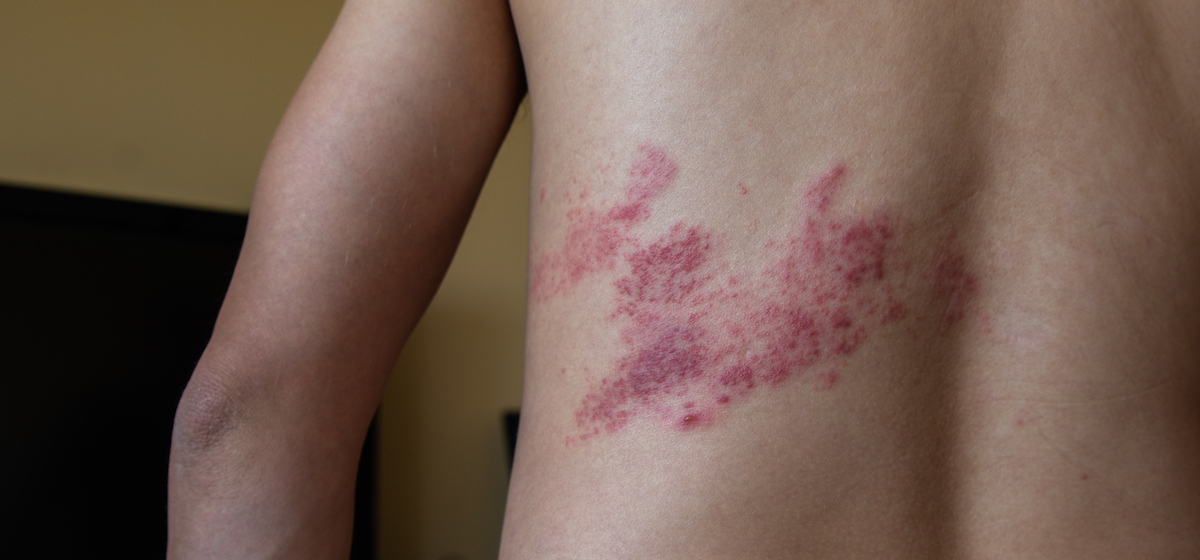This painful rash is caused by the varicella zoster virus that also causes chickenpox. If you have ever had or been exposed to chickenpox, it’s more than likely that you have this virus, which can lie dormant for decades without harming the host. However, it can ‘wake up’ and move to the skin along nerve fibres, causing the shingles rash.
One-quarter of people will experience shingles at some time in their lives, and people aged over 60 are 10 times more likely to develop it. People who have experienced stress and trauma, those with weak immune systems and those taking steroids or some cancer medicines are more at risk of developing shingles. People with HIV and AIDS and those who have had an organ or bone marrow transplant are also more susceptible.
The term shingles comes from the Latin word for belt, because the distinctive rash often appears wrapping around one side of the waist. While this rash can occur anywhere, it most often forms around the waist, forehead or around one eye.
Rashes that target the ear can cause balance and hearing problems, and those that appear around the eye can cause temporary or permanent vision loss. In some serious cases shingles may affect the spinal cord and brain.
The rash looks like a cluster of blisters filled with fluid and is so distinctive that your doctor will likely be able to diagnose shingles on appearance alone. These blisters scab over after seven to 10 days of appearing and will completely disappear in two weeks to a month. However, for people with weak immune systems these symptoms may last longer.
Two to three days prior to the outbreak of the rash, you may experience tingling, itching, burning, stabbing sensations and pain in the area. Other, lesser-known symptoms include headache, fever, chills, sensitivity to touch, fatigue, numbness and an upset stomach.
At the first sign of shingles, doctors recommend taking antiviral medication that can help to slow and shorten the attack. Over the counter medication can help to ease the itchiness of the rash, while anti-inflammatory drugs can be prescribed by your doctor to help reduce inflammation. At home, laying a cool damp cloth over the rash can help to speed up the drying of the blisters. Try to avoid touching or scratching the blisters. There is currently no cure for shingles, though early intervention can help to reduce the severity of symptoms.
While for most people, the pain associated with singles goes away with the rash, nerve damage known as postherpetic neuralgia can cause pain for months or years after. For some people this is severe enough to cause serious mental health conditions such as depression and insomnia.
While exposure to shingles blisters will not trigger the rash in another person, is can cause chickenpox in children and people who have not yet been exposed to the virus. For this reason, it is best to keep the rash covered and avoid contact with children, infants and people with weak immune systems.
If you are over 60, or over 50 and living with someone who is immunocompromised, Health Direct recommends getting the shingles vaccine, an injection that can help to protect against the rash. This vaccine is free for adults aged between 70 and 79.
Have you developed chickenpox or shingles in the past? Are you worried about developing shingles as you age?
If you enjoy our content, don’t keep it to yourself. Share our free eNews with your friends and encourage them to sign up.
Related articles:
https://www.yourlifechoices.com.au/news/waging-war-on-shingles
https://www.yourlifechoices.com.au/health/your-health/diseases/lymph-node-swelling-explained
https://www.yourlifechoices.com.au/health/how-to-control-nerve-pain
Disclaimer: This article contains general information about health issues and is not advice. For health advice, consult your medical practitioner.

